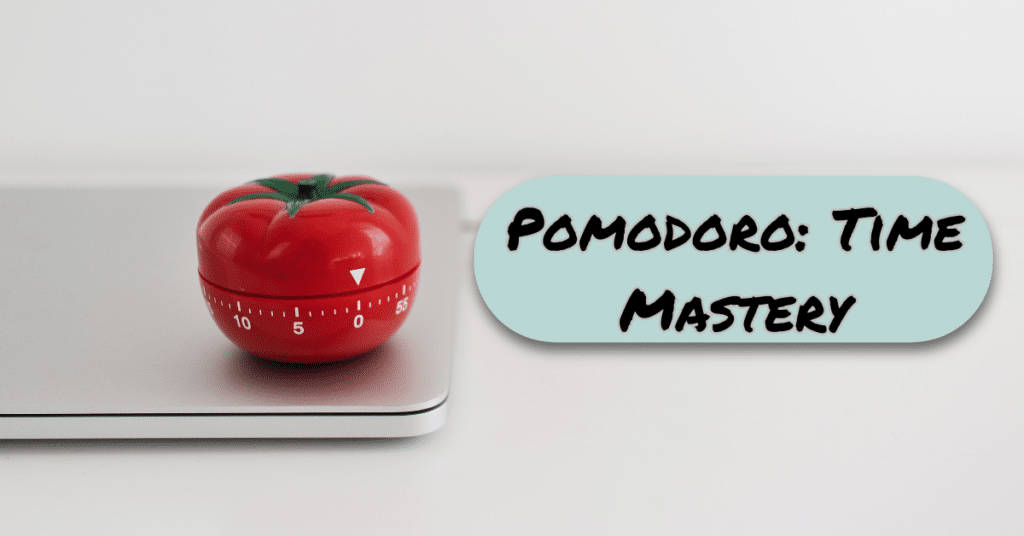In today’s fast-paced world, maintaining focus and productivity can be a constant challenge. The Pomodoro Technique, developed by Francesco Cirillo in the late 1980s, offers a structured approach to tackling tasks and enhancing productivity. This time management method has gained popularity among students, professionals, and creatives alike for its simplicity and effectiveness. In this comprehensive guide, we will delve into the science behind the Pomodoro Technique, explore how to get started with it, share valuable tips for maximizing your focus during Pomodoro sessions, and discuss various variations of the technique to help you find what works best for your unique needs and preferences.
Understanding the Pomodoro Technique: A Brief Overview

The Pomodoro Technique, a time management method developed by Francesco Cirillo in the late 1980s, has become a popular strategy for improving productivity and focus. This technique involves breaking your work into focused intervals, typically 25 minutes in length, separated by short breaks. The approach is named after the Italian word for “tomato” due to the tomato-shaped kitchen timer that Cirillo initially used. In this brief overview, we’ll explore the core principles of the Pomodoro Technique and its potential to revolutionize the way you approach tasks, helping you accomplish more in less time while maintaining mental clarity and motivation.
The Science Behind Pomodoro: Why It Works
The Pomodoro Technique isn’t just a simple timer-based method; it’s grounded in cognitive science. The concept of working in short, focused bursts aligns with research on attention spans and mental fatigue. These 25-minute intervals, known as Pomodoros, utilize a psychological phenomenon called the “Zeigarnik Effect,” which suggests that people remember incomplete or interrupted tasks better than completed ones. Additionally, the structured breaks in the Pomodoro Technique help prevent burnout, maintain mental clarity, and sustain productivity over extended periods. Understanding the scientific foundations behind the Pomodoro Technique provides valuable insights into why it’s such an effective tool for enhanced focus and productivity.

The Zeigarnik Effect and Task Retention
The Pomodoro Technique leverages a psychological phenomenon known as the Zeigarnik Effect, which suggests that people tend to remember and stay more engaged with tasks that are incomplete or interrupted. In the context of the Pomodoro Technique, this means that when you work on a task for a focused 25-minute Pomodoro session and then take a short break, your brain remains engaged with the unfinished task during the break. This phenomenon can enhance task retention and motivation, making it easier to pick up where you left off and continue making progress.
Key Points:
- The Zeigarnik Effect explains why interrupted or incomplete tasks stay on our minds.
- Pomodoro’s timed intervals capitalize on this effect, increasing our commitment to the task.
- Enhanced task retention can lead to a sense of accomplishment and sustained productivity.
Cognitive Load and Mental Fatigue
One of the core reasons behind the Pomodoro Technique’s effectiveness lies in its ability to manage cognitive load and prevent mental fatigue. Extended periods of focused work can lead to diminishing returns as the brain gets tired and starts to lose efficiency. By breaking work into 25-minute intervals, followed by short breaks, the Pomodoro Technique helps maintain cognitive freshness. This reduces the risk of burnout, mental exhaustion, and decision fatigue, ultimately allowing you to work more productively over an extended period.
Key Points:
- Continuous work can lead to cognitive overload and decreased productivity.
- Short breaks in Pomodoro intervals provide moments of mental rest.
- Maintaining cognitive freshness leads to sustained productivity and less mental fatigue.
Interval Training for the Brain
Analogous to physical interval training, the Pomodoro Technique introduces a structured approach to interval training for the brain. By alternating focused work sessions (Pomodoros) with brief breaks, you effectively train your brain to maximize productivity. These intervals help maintain mental agility, prevent mental stagnation, and improve task-switching capabilities. Over time, this brain training can lead to improved concentration and productivity, making it a valuable technique for tackling demanding tasks.
Key Points:
- Pomodoro Technique employs intervals to train the brain for improved productivity.
- Regular, structured breaks enhance mental agility and task-switching.
- Consistent practice can lead to heightened concentration and task efficiency.
Aspect |
Key Points |
|---|---|
Zeigarnik Effect |
- Explains task retention for incomplete tasks |
- Pomodoro intervals leverage this phenomenon |
|
- Enhanced task retention leads to motivation |
|
Cognitive Load and Mental Fatigue |
- Continuous work leads to cognitive overload |
- Short breaks in Pomodoro maintain freshness |
|
- Reduced mental fatigue and decision fatigue |
|
Interval Training for the Brain |
- Structured brain training like physical HIIT |
- Maintains mental agility and task-switching |
|
- Improved concentration and task efficiency |
Getting Started: How to Implement the Pomodoro Technique
Implementing the Pomodoro Technique is a straightforward process that can have a profound impact on your productivity. To begin, all you need is a timer or a Pomodoro app, readily available on various devices. Start by selecting a task you’d like to work on, set the timer for 25 minutes (a single Pomodoro session), and immerse yourself in focused work. When the timer rings, take a short 5-minute break to recharge. After completing four Pomodoro sessions, reward yourself with a more extended 15-30 minute break. The key to success with the Pomodoro Technique is consistency, so find a rhythm that works for you, stay disciplined, and watch your productivity soar while maintaining a healthy work-life balance.
Maximizing Focus: Tips for a Successful Pomodoro Session
Achieving peak productivity during Pomodoro sessions involves more than just setting a timer. To make the most of your focused work intervals, consider optimizing your environment. Find a quiet space, minimize distractions, and ensure you have all the necessary materials at hand. Prioritize tasks and break them down into manageable chunks, making it easier to tackle them within a single Pomodoro. Additionally, embrace the natural ebb and flow of your energy levels by scheduling more challenging or creative tasks during your peak hours. Lastly, use the short breaks between sessions to recharge, stretch, or practice mindfulness, further enhancing your ability to concentrate during the next Pomodoro. By implementing these tips, you can maximize your focus and productivity, harnessing the full potential of the Pomodoro Technique.

Creating a Distraction-Free Workspace
A distraction-free workspace is essential for maximizing focus during Pomodoro sessions. Consider these strategies to create an environment conducive to productivity:
- Declutter: Remove unnecessary items from your workspace to reduce visual distractions.
- Silence Notifications: Turn off or mute notifications on your devices to prevent interruptions.
- Use Noise-Canceling Headphones: These can help block out background noise and keep you in the zone.
- Time Blocking: Let others know when you’re in a Pomodoro session to minimize interruptions.
- Limit Multitasking: Focus on one task at a time to maintain concentration.
Optimizing Task Selection and Prioritization
Choosing the right tasks for your Pomodoro sessions is crucial for success. Follow these guidelines to optimize task selection and prioritization:
- Break Tasks Down: Divide larger tasks into smaller, manageable subtasks that can be completed within a Pomodoro.
- Prioritize: Start with high-priority or challenging tasks to ensure they receive your freshest, most focused energy.
- Batch Similar Tasks: Group similar tasks together to reduce mental context-switching.
- Set Clear Goals: Define what you want to achieve during each Pomodoro session.
- Experiment and Adapt: Be flexible and adjust your task selection based on your performance and energy levels.
By implementing these strategies, you can fine-tune your Pomodoro sessions for maximum focus and productivity, ultimately making the most of your work or study time.
Pomodoro Technique Variations: Finding What Works for You
While the traditional Pomodoro Technique involves 25-minute focused work sessions followed by 5-minute breaks, it’s important to recognize that one size does not fit all when it comes to productivity. Variations of the Pomodoro Technique exist to accommodate different preferences and work styles. Some people may find longer or shorter Pomodoro intervals better suited to their needs, while others may prefer variations that incorporate techniques like the “Two-Minute Rule” or “Pomodoro Sprint.” Exploring these variations allows you to customize the technique to your unique working rhythm, enhancing its effectiveness in improving your focus, productivity, and overall work-life balance.
Conclusion

The Pomodoro Technique, a time management method created by Francesco Cirillo, has become a valuable tool for improving productivity and focus in today’s fast-paced world. In this guide, we explore the science behind its effectiveness, provide practical advice on implementing the technique, share tips for maximizing your productivity during Pomodoro sessions, and discuss various variations to help you customize the approach to your specific needs. Whether you’re a student, professional, or anyone looking to enhance your efficiency, understanding the Pomodoro Technique can be a game-changer for your work and study habits.












